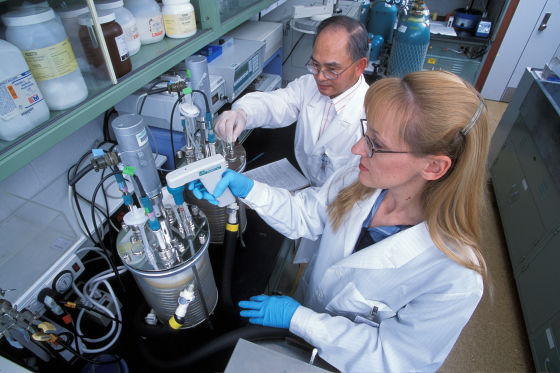Develop technology to transform sugar into jet fuel using metal and bacteria

Although a mechanism that uses air and water as an energy source is made, it becomes alternative fuel using bacteriaBio fuelIt is an organic resource of renewable biological originbiomassMany researches have been done on the generation of resources, but a new way to create jet fuel from sugars using metals and bacteria by the University of California research has been developed.
More Bang for the Biofuel Buck << Berkeley Lab News Center
http://newscenter.lbl.gov/news-releases/2012/11/08/more-bang-for-the-biofuel-buck/
Integration of chemical catalysis with extractive fermentation to produce fuels: Nature: Nature Publishing Group
http://www.nature.com/nature/journal/v491/n7423/full/nature11594.html
Combined bacterial / metal catalysis turns sugars to jet fuel | Ars Technica
http://arstechnica.com/science/2012/11/combined-bacterialmetal-catalysis-turns-sugars-to-jet-fuel/

There are two main types of biomass resource generation methods, fermentation and chemical reactions, fermentation methods have synthesized methane, ethanol · butanol, diesel fuel, etc. from chemical reactions. The production of biomass resources by the fermentation method was studied around 1910, especially in the 1950s after the Second World War, raw materials for synthesizing aviation fuel,ButanolIt was heavily used to generate. Due to the development of the petrochemical industry, it has declined since then, but with the depletion problem of fossil fuels, acetone · butanol fermentation (ABE fermentation) to produce butanol is now carried out much now. Three kinds of acetone, butanol and ethanol are finally produced by this ABE fermentation but because butanol has a larger calorific value than ethanol and is efficient as a fuel, how to reduce the synthesis amount of acetone and ethanol, total It is important to raise the ratio of butanol in the solvent.
Therefore, the research team of the University of California in the United States newly developed,Clostridium acetobutylicumHow to make a new biomass fuel by combining the traditional fermentation method with the power of bacteria called chemical reaction using chemical catalyst. ABE fermentation usually produces small carbon compounds such as acetone and ethanol · butanol by adding sugar which is raw material to bacteria. However, in these carbon compounds only carbon is contained at most 4, and all of the compounds incorporate oxygen into the structure. In a new study this carbon compoundAlkylationTo produce more efficient biomass fuels.
These metabolic actions are carried out until they become harmful to the bacteria they produce, and the reaction ends when they become harmful. Therefore, researchers at the University of California have found a solution to use glyceryl tributyrate, which is immiscible with water when generating compounds. Glyceryl tributyrate preferentially dissolves acetone and butanol and separates them from the water the bacteria inhabits. Since ethanol is also left behind at this time, there is a possibility that ethanol can be reused as another biofuel.
Then, in a carbon compound once separated, a condensation reaction is caused by using a metal such as palladium as a catalyst. Water molecules are released in this reaction, butanol binds with acetone. At the same timeKetoneLeave the organic compound called. The ketone is very similar in structure to acetone in the first reaction and undergoes another condensation reaction, resulting in a compound composed of eleven carbons with interposed ketones. It is said that this compound occupies about half of all the compounds born by the reaction. This is different from conventional hydrocarbon fuel, but because it has a burning method very similar to diesel fuel, it can also be used as a raw oil for diesel fuel and jet fuel. A little more than the existing raw oil, but because there is a limit on natural fuel, this biofuel is considered for future use as an alternative fuel.

ByCaribb
One of the problems with this biofuel is that palladium used as a catalyst is very expensive. However, according to researchers, it is possible to react 3000 moles of product with 1 mole of palladium, and it is thought that the cost will not become a problem so far. Moreover, there is a similar effect, and a cheaper catalyst may be found in the future, too.
Yet another problem is that a mixture of complex hydrocarbons containing oxygen is produced during the reaction. Perhaps there may be methods that can be used effectively, but in any case it is necessary to isolate this mixture somehow before using it as a diesel engine.
Although research on biofuels has been conducted focusing on either fermentation method or chemical catalyst, this time it was said that more effective biofuel was developed by using both of them. There is a bottleneck in price, but this biofuel should play a big role in future.

ByUSDAgov
Related Posts:
in Science, Posted by darkhorse_log







